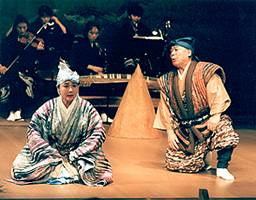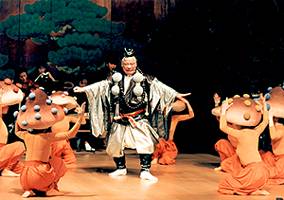| A special production of the Twin Opera “THE RIVER SUMIDA” and
“KUSABIRA”
 This twin opera was commissioned by GEIDANKYO , an organization
for Japanese stage artists groups. It premiered in 1995 and was
produced by the Produce Center. Minoru Miki composed his sixth
opera as a combination of a tragedy and a comedy based upon a
famous Noh and Kyogen Play. The plan and the libretto made by
Mr. Asaya Fujita who has cooperated with Miki for more than thirty
years in the theatrical field. This twin opera had to perform
in a usual Noh theatre; it has special traditional scenery but
no orchestra pit and must be performed under fixed lighting. Also
the space is limited because of the theatre’s traditional use.
Miki has kept the opera’s vocal and instrumental numbers as minimum
as possible, and the opera can perform without conductor when
required. Miki’s five regular operas need an orchestra pit and
many singers, and their performances last more than two hours.
So this twin opera is Miki’s only chamber opera. The opera is
very suitable as a touring production in foreign country’s not
only because of its small staff and minimal equipment, but also
because it represents traditional Japanese theatre. The opera
.can perform by approximately 10 singers including the chorus,
5 instrumental players and 6 dancers. This twin opera was commissioned by GEIDANKYO , an organization
for Japanese stage artists groups. It premiered in 1995 and was
produced by the Produce Center. Minoru Miki composed his sixth
opera as a combination of a tragedy and a comedy based upon a
famous Noh and Kyogen Play. The plan and the libretto made by
Mr. Asaya Fujita who has cooperated with Miki for more than thirty
years in the theatrical field. This twin opera had to perform
in a usual Noh theatre; it has special traditional scenery but
no orchestra pit and must be performed under fixed lighting. Also
the space is limited because of the theatre’s traditional use.
Miki has kept the opera’s vocal and instrumental numbers as minimum
as possible, and the opera can perform without conductor when
required. Miki’s five regular operas need an orchestra pit and
many singers, and their performances last more than two hours.
So this twin opera is Miki’s only chamber opera. The opera is
very suitable as a touring production in foreign country’s not
only because of its small staff and minimal equipment, but also
because it represents traditional Japanese theatre. The opera
.can perform by approximately 10 singers including the chorus,
5 instrumental players and 6 dancers.
The story of “THE RIVER SUMIDA”
The original Noh play of this story created in 15th Century.
At the beginning of the play, 6~8 people sing a sutra while walking
along the Sumida River, a famous river passing on the east side
of Edo (old Tokyo). They are Nenbutsu-shu (a kind of pilgrim)
and also recite an “Ode to Spring”. Enter a passenger and then
a ferryman. After their song, a crazy woman comes in. This woman
led an ordinary life with her 12 year-old-son in Kyoto, which
was the capital until 19th Century. One year ago, an evil minded
merchant brought the son out to the eastern country to sell him.
The woman went crazy. She appears by the River Sumida as a female
entertainer who does a crazy dance.
After she rides in the small ferry boat, the ferryman tells her
a sad story which happened just one year ago:
A boy has reached to the bank of Sumida River. He is so weak,
he is almost dead. The boy says to the ferryman “Please build
a tomb for me by the river after I die, because I hope to see
passengers from the tomb.” Then he passes away. This is the story
the ferryman tells the woman on the boat. The crazy woman feels
that the boy must have been her own son, and weeps deeply. After
arrivinge on the other side of the river, the ferryman said to
her “Let visit his tomb, and pray with sutra”. During the sutra,
she can hear her son’s voice as they sing together. She also sees
his image behind the tomb. Suddenly, however, the image disappears
and only spring glass remains on the bank.……
Even at present, many kidnap incidents occur in every where. Miki
devoted his composition praying to never happen such a sad incident.
<NB> This story is used by Benjamin Britten in English for his
famous church opera “Curlew River”. The world premiere of the
opera has directed by Colin Graham who premiered Miki’s second
opera ”An Actor’s Revenge” in 1979 and third opera “Joruri” in
1985. He also wrote the libretto of Miki’s seventh opera “The
Tale of Genji” which will premiere in 2000 under Graham’s direction
by the Opera Theatre of Saint Louis, U.S.A.
 The story of “KUSABIRA” The story of “KUSABIRA”
Tokoro-no-mono (a person in the village) feels uneasy when some
huge Kusabira (mushrooms) sprout up in his house. He asks Yamabushi
(a Buddhist monk) to pray for the Kusabira to vanish. Alas! But
his praying cause the Kusabira to increase more and more. Miki
sets these mushrooms to symbolize the ladies who have been disgraced
by the phony Yamabushi. So the story moves to our contemporary
society. |
 This twin opera was commissioned by GEIDANKYO , an organization
for Japanese stage artists groups. It premiered in 1995 and was
produced by the Produce Center. Minoru Miki composed his sixth
opera as a combination of a tragedy and a comedy based upon a
famous Noh and Kyogen Play. The plan and the libretto made by
Mr. Asaya Fujita who has cooperated with Miki for more than thirty
years in the theatrical field. This twin opera had to perform
in a usual Noh theatre; it has special traditional scenery but
no orchestra pit and must be performed under fixed lighting. Also
the space is limited because of the theatre’s traditional use.
Miki has kept the opera’s vocal and instrumental numbers as minimum
as possible, and the opera can perform without conductor when
required. Miki’s five regular operas need an orchestra pit and
many singers, and their performances last more than two hours.
So this twin opera is Miki’s only chamber opera. The opera is
very suitable as a touring production in foreign country’s not
only because of its small staff and minimal equipment, but also
because it represents traditional Japanese theatre. The opera
.can perform by approximately 10 singers including the chorus,
5 instrumental players and 6 dancers.
This twin opera was commissioned by GEIDANKYO , an organization
for Japanese stage artists groups. It premiered in 1995 and was
produced by the Produce Center. Minoru Miki composed his sixth
opera as a combination of a tragedy and a comedy based upon a
famous Noh and Kyogen Play. The plan and the libretto made by
Mr. Asaya Fujita who has cooperated with Miki for more than thirty
years in the theatrical field. This twin opera had to perform
in a usual Noh theatre; it has special traditional scenery but
no orchestra pit and must be performed under fixed lighting. Also
the space is limited because of the theatre’s traditional use.
Miki has kept the opera’s vocal and instrumental numbers as minimum
as possible, and the opera can perform without conductor when
required. Miki’s five regular operas need an orchestra pit and
many singers, and their performances last more than two hours.
So this twin opera is Miki’s only chamber opera. The opera is
very suitable as a touring production in foreign country’s not
only because of its small staff and minimal equipment, but also
because it represents traditional Japanese theatre. The opera
.can perform by approximately 10 singers including the chorus,
5 instrumental players and 6 dancers.
 The story of “KUSABIRA”
The story of “KUSABIRA”
